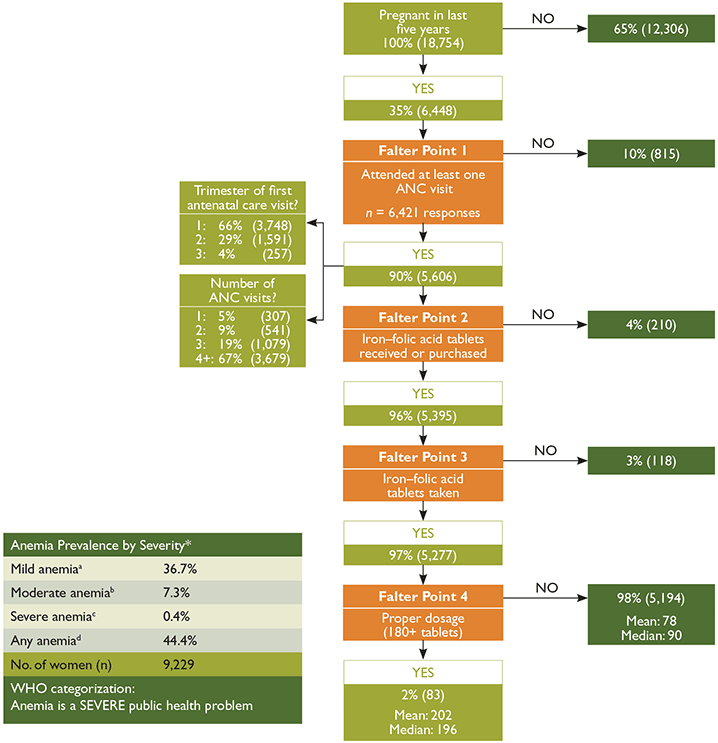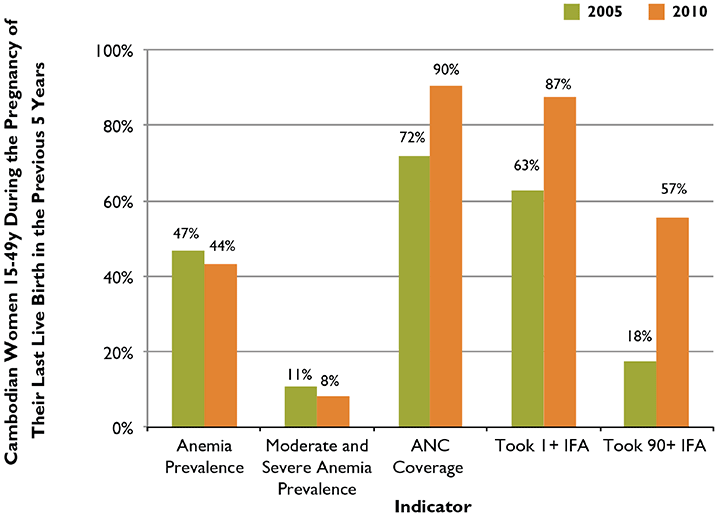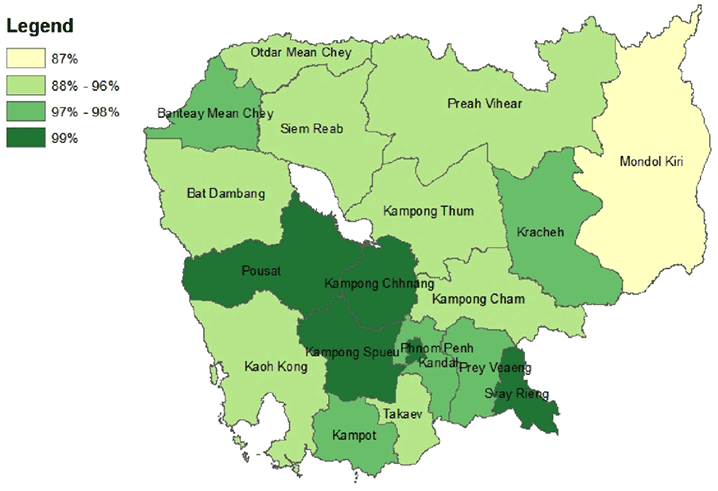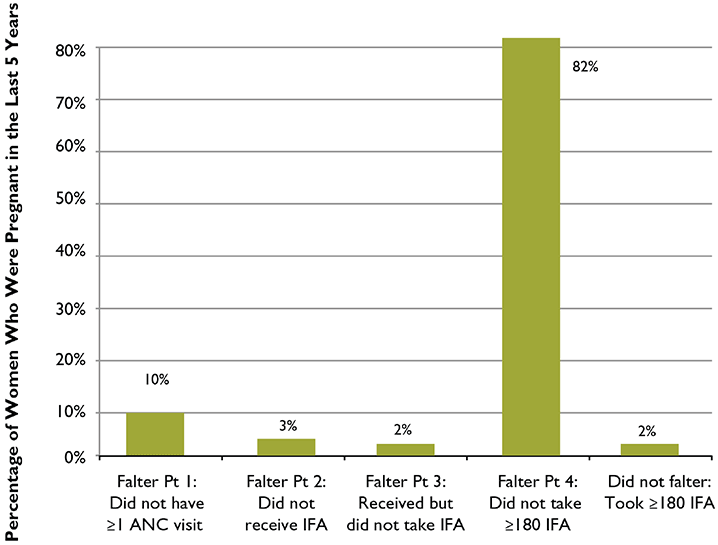Overview of the Global Anemia Problem, Including Iron Deficiency Anemia
The World Health Organization (WHO) defines anemia among women of childbearing age as the condition of having a hemoglobin concentration of < 12.0 g/dL at sea level; among pregnant women it is defined as < 11.0 g/dL. The hemoglobin concentration cutoff level that defines anemia varies by age, gender, physiological status, smoking status, and the altitude at which the assessed population lives.
The primary cause of anemia is iron deficiency, a condition caused by inadequate intake or low absorption of iron, the increased demands of repeated pregnancies—particularly if not well spaced (e.g., fewer than 36 months between pregnancies)—and loss of iron through menstruation. Other causes of anemia include vitamin deficiencies (such as a deficiency of folic acid or vitamin A), genetic disorders, malaria, parasitic infections, HIV, tuberculosis, common infections, and other inflammatory conditions. While iron deficiency anemia (IDA) accounts for about onehalf of all anemia cases, it often coexists with these other causes.
Iron deficiency anemia is most common during pregnancy and in infancy, when physiological iron requirements are the highest and the amount of iron absorbed from the diet is not sufficient to meet many individuals’ requirements (Stoltzfus and Dreyfuss 1998). Anemia’s effects include increased risk of premature delivery, increased risk of maternal and child mortality, negative impacts on the cognitive and physical development of children, and reduced physical stamina and productivity of people of all ages (Horton and Ross 2003). Globally, IDA annually contributes to over 100,000 maternal deaths (22 percent of all maternal deaths) and over 600,000 perinatal deaths (Stoltzfus, Mullany, and Black 2004). Key anemia control interventions include promoting a diversified diet, iron-folic acid (IFA) supplementation during pregnancy, iron fortification of staple foods, prevention and treatment of malaria, use of insecticide-treated bed nets, helminth prevention and control, delayed cord clamping, and increased birth spacing.
Maternal Anemia in Cambodia
The prevalence of anemia among pregnant women in Cambodia is 53 percent, making it a severe public health problem as defined by WHO standards1 (NIS, DGH, and ICF Macro 2011). In terms of anemia severity, the majority of cases among pregnant and breastfeeding or non-pregnant women reported in the 2010 Cambodia Demographic and Health Survey (CDHS) are classified as mild or moderate.2 Less than one percent of anemia cases among these groups of women are diagnosed as severe. Since 2000, the prevalence of maternal anemia has fallen by more than 10 percentage points. This drop is largely due to decreases in moderate anemia (NIS, DGH, and ORC Macro 2001).
Falter Points in Women's Consumption of Iron-Folic Acid During Pregnancy
WHO recommends that all pregnant women receive a standard dose of 30–60 mg iron and 400 μg folic acid beginning as soon as possible during gestation (WHO 2012a). Ideally, women should receive iron-containing supplements no later than the first trimester of pregnancy, which means ideally taking 180 tablets before delivery. It is important to note, that many countries aim for women to receive 90 or more tablets during pregnancy.
Figure 1 shows a decision-tree analysis of how well the Cambodian antenatal care (ANC) system distributes IFA, and identifies four potential points at which the system might falter (highlighted in orange). The figure tracks the number and percentage of women who obtained ANC, those who subsequently received and consumed at least one IFA tablet, and those who consumed the ideal minimum number of tablets.3 All data are based on CDHS questions asked of women who were in permanent unions and had been pregnant in the five years prior to being interviewed4 (NIS, DGH, and ICF Macro 2011).
Figure 1. Analysis of Falter Points Related to Distribution and Consumption of IFA through Cambodia’s ANC Program in 2010, Women of Reproductive Age (15–49 years) n = 18,754

Main Conclusions: ANC coverage is high, providing an outstanding platform for IFA distribution. Among women who were pregnant in the last five years, had at least one ANC visit, and took at least one IFA tablet, only two percent received and took the ideal minimum number of tablets. The most important shortcoming of the system is Falter Point 4. Supply and demand considerations are both likely constraints to improving IFA distribution.
Percentages are calculated from weighted data and may vary slightly from the unweighted observations-based calculations. four percent of women who were pregnant in the last five years did not have any ANC visits but received or purchased IFA from another source.
*Percentage of women 15–49 years based on Hemoglobin levels, Hb (g/dL)
aNPW 10.0≤Hb≤11.9, PW 10.0≤Hb≤10.9 b NPW 7.0≤Hb<9.9, PW 7.0≤Hb<9.9 cNPW Hb<7.0, PW Hb<7.0 dNPW Hb<12.0, PW Hb<11.0
Non-responses, no data (NR/ND) were recoded to “No” for ‘“At least one ANC visit?”, “IFA tablets received?” and “IFA tablets taken?” and to zero for “Number of tablets taken?”.
Anemia prevalence data are provided as a reference point, signaling the general order of magnitude of the anemia public health problem. The ANC utilization data is based on self-reported data of women 15–49 years in permanent unions and pertains to their last pregnancy in the last five years prior to the DHS.
Source: Calculations and anemia levels are from the Cambodia Demographic and Health Survey (2010).
Many supply-side aspects—including both adequacy of IFA tablet supplies and technical knowledge and practices of ANC providers—need to be considered when assessing how well an ANC program delivers IFA. In addition, as Falter Point 4 in Figure 1 clearly shows, the provision of IFA tablets to a pregnant woman is a necessary but not sufficient condition for the woman to consume the tablets, particularly at the ideal minimum level. Thus, demand-side factors also play a critical role in determining the coverage and effectiveness of a program. These include whether or not women seek ANC and the timing and number of visits, as well as the extent to which women are aware of the significance of anemia and IFA, ask for IFA tablets, and comply with the IFA regimen.
Understanding the relative significance of each falter point makes it possible to prioritize them for more in-depth analysis, providing a first step in an evidence-based approach to systematically improving the program. The DHS does not collect information on the number of IFA tablets received by women. In the case of Falter Point 4, this lack of data creates ambiguities that make it impossible to fully understand whether shortcomings in the system relate primarily to supply- or demand-side factors. Despite this limitation, the decision-tree analysis presented in Figure 1 still enables prioritizing the falter points for more in-depth analysis and action at the national, district, and health center levels.
Analysis of Falter Points
Falter Point 1:
Did not attend at least one ANC visit
Only 10 percent of women did not have at least one ANC visit.
ANC’s high coverage gives it great potential as a vehicle for providing IFA.
Falter Point 2:
Did not receive or purchase at least one IFA tablet
Of the women who had at least one ANC visit, 4 percent did not receive or purchase any IFA.
This supply-side constraint is relatively small and may be due to various system/supply-side performance shortcomings, which could reflect: (1) inadequate supply (e.g., stockouts); (2) inadequate provider knowledge; or (3) inadequate provider practices, whereby IFA may not have been provided. This is the third-most important falter point among all women in Cambodia.
Unfortunately, the CDHS does not report the source(s) of the IFA tablets women received or purchased, and a small percentage of women attending ANC get IFA tablets from a different source. While only 3 percent of Cambodian women who received or purchased IFA did not have any ANC visits (not shown), we cannot ascertain whether or not those who received ANC care obtained their IFA from their ANC provider. However, women who attend ANC may be more likely to be aware of, to value, and also to take IFA tablets, regardless of where they obtain them. Thus, we would expect a high correlation between the number of women who had at least one ANC visit and those who received or purchased IFA, which is consistent with the data. Women who had one or more ANC visits and who did not receive any IFA represent a missed opportunity to reduce the risk of anemia among a high-risk population.
Falter Point 3:
Did not take at least one IFA tablet
Of the women who received IFA, three percent did not take any tablets.
This demand-side constraint is relatively small and may be due to women not understanding the significance of anemia and/or the significance of IFA. This misunderstanding may reflect: (1) inadequate provider counseling and follow-up; (2) women’s beliefs about actual or possible side effects; or (3) sociocultural factors.
Falter Point 4:
Did not consume 180 or more IFA tablets
Of the women who received and took IFA, 98 percent did not consume the ideal minimum of 180 IFA tablets.
This constraint results from a combination of supplyand/ or demand-side factors. Figure 1 suggests two possible causes of this falter point: 33 percent of women who received ANC began their care after the first trimester, and the 33 percent who had fewer than WHO’s recommended four ANC visits during their last pregnancy may have started their ANC too late or may not have had enough visits to receive 180 tablets (given IFA distribution protocols). Both of these are likely contributing factors, but further research is needed to establish their relative importance, as well as the significance of other possible causes.
Globally, research has found that other common causes of Falter Point 4 include: (1) providers do not have access to adequate supply; (2) women do not receive an adequate number of tablets because they have little access to care, start ANC late, or do not have enough ANC visits, making it difficult to obtain 180 tablets (given IFA distribution protocols); (3) providers do not provide adequate counseling or follow-up; (4) women do not adhere to the regimen, which may be due to difficulty in remembering to take the tablets daily, not knowing all the tablets are necessary, fear of having a big baby, side effects, or tablet-related issues (taste, size, color, coating, packaging/storage problem). Further research is needed to determine the specific reasons for this falter point in Cambodia.
Analysis By Sociodemographic Variables and Trends Over Time
A comparison of 2005 and 2010 CDHS data (Table 1) reveals that Cambodia has made remarkable progress in improving coverage of pregnant women and the timeliness of their care: (1) the coverage of ANC increased from 72 percent to 90 percent; (2) the percentage of women who had four or more ANC visits more than doubled; (3) the percentage of women who had their first ANC visit during their first trimester increased 157 percent, from 23 percent to 59 percent; and (4) the median month in which ANC was initiated fell from 4.2 to 3.4 months.
Table 1. Number and Timing of ANC Visits in Cambodia, 2005 and 2010
| Indicator | 2005 | 2010 | Change in Coverage | Percentage Change |
|---|---|---|---|---|
| Number of ANC Visits | ||||
| Months of First Visit | ||||
| Median Months Pregnant at First Visit | ||||
| 0 | 28% | 10% | -18% | -63% |
| 1 | 11% | 5% | -6% | -57% |
| 2-3 | 33% | 25% | -8% | -24% |
| 4+ | 27% | 59% | 32% | 120% |
| Don't Know/No Data | 1% | |||
| No Antenatal Care | 28% | 10% | -18% | -63% |
| < 4 | 23% | 59% | 36% | 157% |
| 4-5 | 26% | 22% | -4% | -14% |
| 6-7 | 17% | 7% | -10% | -60% |
| 8+ | 6% | 1% | -5% | -76% |
| Don't Know/No Data | 0.1% | 0.0% | -0.1% | -100% |
| 4.2 | 3.4 | |||
Figure 2. Prevalence of Anemia and Coverage of ANC and IFA among Cambodian Women 15–49 Years During the Pregnancy of Their Last Live Birth in the Past Five Years, 2005 and 2010

Between 2005 and 2010, the prevalence of anemia fell from 47 percent to 44 percent, a decline of 6 percent (Figure 2). During the five-year period, however, Cambodia was able to reduce moderate and severe anemia by nearly one-third. A number of major improvements in the distribution of IFA through ANC—including a 25 percent increase in ANC coverage, a 38 percent increase in the percentage of women who received and took at least one IFA tablet during their last pregnancy, and a threefold increase in the percentage of women taking 90 or more IFA tablets—all suggest that it is highly plausible that IFA supplements contributed to reducing anemia and particularly its severity. Although anemia remains a severe public health problem in Cambodia by global standards, the magnitude of changes in these indicators is a major accomplishment.
Table 2 takes a closer look at interprovincial variation, showing that, while nationwide ANC coverage is high, at 90 percent, and 14 of Cambodia’s 19 provinces have ANC coverage rates of 88 percent or more, significant variation does exist. Three sets of provinces (five provinces in total) have ANC attendance rates below 67 percent. These provinces—Kratie, Preah Vihear/ Steung Treng, and Mondol Kiri/Rattanak Kiri—have high anemia prevalence rates (47 percent or more), the lowest IFA coverage rates (defined as the percentage of women, among all women who were pregnant in the past five years, who received and took at least one IFA tablet), and three of the four lowest percentages of women who took 90 or more IFA tablets during their last pregnancy. These provinces should be targeted for efforts to improve their ANC and IFA coverage.
As shown in the bottom portion of Table 2, the prevalence of anemia and of severe anemia are both inversely related to wealth quintile and are both higher in rural areas. In contrast, ANC coverage, the percentage of pregnant women taking IFA, and the percentage taking at least 90 IFA tablets are all directly related to wealth quintile and are lower in rural areas.
Table 2. Prevalence of Anemia and Coverage of ANC and IFA among Cambodian Women aged 15–49 Years
| Characteristic | Prevalence of Anemia | Prevalence of Moderate & Severe Anemia | ANC Coverage* | All Pregnant Women* | |
|---|---|---|---|---|---|
| Took 1 + IFA | Took 90 + IFA | ||||
| Province | |||||
| Residence | |||||
| Wealth | |||||
| Banteay Mean Chey | 38.7% | 6.4% | 88.3% | 88.2% | 71.6% |
| Kampong Cham | 41.4% | 6.1% | 88.2% | 78.7% | 33.0% |
| Kampong Chhnang | 57.1% | 12.2% | 90.6% | 91.5% | 49.6% |
| Kampon Speu | 46.5% | 6.5% | 91.3% | 88.0% | 64.9% |
| Kampong Thom | 53.3% | 10.5% | 86.1% | 84.6% | 47.9% |
| Kandal | 44.9% | 6.5% | 89.0% | 89.1% | 63.1% |
| Kratie | 55.1% | 10.9% | 65.5% | 77.0% | 45.6% |
| Phnom Penh | 33.9% | 3.6% | 99.1% | 98.1% | 83.3% |
| Prey Veng | 41.2% | 6.3% | 92.1% | 92.8% | 69.5% |
| Pursat | 26.3% | 4.3% | 92.8% | 92.3% | 67.3% |
| Siem Reap | 46.3% | 10.2% | 94.1% | 87.9% | 61.7% |
| Svay Rieng | 61.9% | 12.7% | 93.3% | 91.7% | 67.3% |
| Takeo | 45.1% | 8.8% | 97.5% | 90.9% | 58.1% |
| Otdar Mean Chey | 46.6% | 5.8% | 91.4% | 87.1% | 67.3% |
| Kattamban/Palin | 53.2% | 11.8% | 93.5% | 84.4% | 56.3% |
| Kampot/Kep | 38.6% | 6.4% | 86.4% | 82.3% | 46.0% |
| Preah Sihanouk/Koh Kong | 38.0% | 6.6% | 88.6% | 84.7% | 47.3% |
| Preah Vihear/Steung Treng | 46.8% | 8.9% | 66.9% | 66.0% | 28.1% |
| Mondol Kiri/Rattanak Kiri | 47.0% | 10.6% | 62.7% | 65.1% | 30.4% |
| Urban | 35.0% | 4.2% | 97.0% | 94.4% | 73.3% |
| Rural | 46.9% | 8.5% | 88.3% | 85.2% | 53.7% |
| Lowest | 52.9% | 11.3% | 79.9% | 78.7% | 43.3% |
| Second | 47.8% | 9.1% | 86.2% | 83.1% | 52.0% |
| Middle | 47.0% | 8.1% | 92.5% | 88.7% | 56.9% |
| Fourth | 43.0% | 6.8% | 95.6% | 91.7% | 63.2% |
| Highest | 34.4% | 4.2% | 98.5% | 95.1% | 75.7% |
| National Average | 44.4% | 7.7% | 89.7% | 86.7% | 56.9% |
Analysis By Geographic Region
Figure 3 shows the variation by province in the percentage of women who attended at least one ANC visit and received at least one IFA tablet. Cambodia is doing well in providing access to ANC and to IFA tablets: all of the provincial coverage levels for IFA are high among women attending ANC. The mean number of tablets taken (not shown) is also fairly consistent across provinces and, when compared with other low- and middle-income countries (LMIC), the number is relatively high, generally ranging from one-quarter to one-half of the ideal minimum of 180 tablets. However, there remains substantial room for improvement.
Figure 3. Percentage of Women Who Had at Least One ANC Visit and Received at Least One IFA Tablet by Province, Cambodia, 2010

Analysis By Number of ANC Visits
In many countries, women attending an ANC visit are provided only a limited number of IFA tablets (for a number of reasons), a number that varies by country protocol and individual ANC provider. Figure 4 suggests that Cambodian women are relatively less constrained by this practice than women in many other LMIC. With 63 percent of women receiving and taking 90 or more tablets, Cambodia outperforms most of these countries. Still, it does appear that the maximum number of IFA tablets that Cambodian women generally receive—independent of the number of ANC visits they have—is 134, less than 75 percent of the ideal minimum of 180 tablets.
Figure 4. ANC Distribution of IFA Tablets: Number of Tablets Received and Taken According to Number of ANC Visits, Cambodia, 2010

Figure 5. Relative Importance of Each of the Falter Points in Cambodia: Why Women Who Were Pregnant in the Last Five Years Failed to Take the Ideal Minimum of 180 IFA Tablets

Note: Due to rounding and missing values, data may not sum to 100 percent.
Overall Conclusions and Recommendations
Figure 5 presents the obstacles among all women— including those who did not receive ANC during their pregnancy—to taking the ideal minimum number of IFA tablets. In Cambodia, Falter Point 4 is the greatest barrier. Improving the delivery of IFA supplementation in Cambodia will require identifying and addressing program gaps in IFA supply management and health workers’ practices, as well as modifying some women’s long-term adherence behaviors. Further investigation is called for to identify the relative significance of these factors and their root causes.
This rapid assessment of the distribution of IFA tablets through Cambodia’s ANC program suggests that, while impressive progress has been made in providing consistently high levels of coverage of ANC, there remains substantial room for improvement. Falter Point 4, which is likely to involve aspects of both the supply-/provider-side and the demand-/client-side of the program, should be the focus of efforts to improve performance. Formative research is required to better understand the specific causes of Falter Point 4, and is essential to identifying priorities and developing strategies to address these factors and thereby increase the ANC-based distribution of IFA.
Between 2005 and 2010, Cambodia’s maternal mortality rate (MMR) fell by 26 percent, from 340 maternal deaths per 100,000 live births to 250 (WHO 2012b). Despite this rapid improvement, Cambodia’s MMR still ranks 141st among 181 countries. Improving the distribution of IFA through the ANC program is an important strategy for preventing and controlling anemia in Cambodia, and for improving the nutrition and health status as well as the mental and physical capacity of women of reproductive age.
Footnotes
1 WHO categorizes anemia’s severity as a public health problem according to the condition’s prevalence: < 5 percent, no public health problem; 5–19.9 percent, mild; 20–39.9 percent moderate; ≥ 40 percent, severe.
2 The DHS hemoglobin levels used to diagnose the severity of anemia in non-pregnant women differ from those specified by WHO. The DHS cutoffs for pregnant (P) and non-pregnant (NP) women in hemoglobin g/dL are mild, 10.0–10.9 (P), 10.0–11.9 (NP); moderate, 7.0–9.9 (P), 7.0–9.9 (NP); severe < 7.0 (P), < 7.0 (NP); any < 11.0 (P), < 12.0 (NP).
3 The CDHS asked about IFA tablets or capsules; this brief refers to all forms as “tablets.”
4 The CDHS provides a population-based, nationally representative sample of all women in Cambodia.
References
Galloway, R. 2003. Anemia Prevention and Control: What Works. Washington, DC: US Agency for International Development.
Horton, S., and J. Ross. 2003. “The Economics of Iron Deficiency.” Food Policy 28(1):51–75.
Ministry of Health (MOH), National Nutrition Programme [Cambodia]. 2011. National Policy and Guidelines for Micronutrient Supplementation to Prevent and Control Deficiencies in Cambodia. Phnom Penh: MOH.
National Institute of Statistics (NIS), Directorate General for Health (DGH) [Cambodia], and ICF Macro. 2011. Cambodia Demographic and Health Survey 2010. Phnom Penh: NIS, DGH, and ICF Macro.
NIS, Directorate General for Health (DGH) [Cambodia], and ORC Macro. 2001. Cambodia Demographic and Health Survey 2000. Phnom Penh: NIS, DGH, and ORC Macro.
National Institute of Public Health (NIPH), National Institute of Statistics (NIS) [Cambodia], and ORC Macro. 2006. Cambodia Demographic and Health Survey 2005. Phnom Penh: NIPH, NIS, and ORC Macro.
Stoltzfus, R. J., and M. L. Dreyfuss. 1998. Guidelines for the Use of Iron Supplements to Prevent and Treat Iron Deficiency Anemia. Washington, DC: ILSI Press.
Stoltzfus, R. J., L. Mullany, and R. E. Black. 2004. “Iron Deficiency Anemia.” In Comparative Quantification of Health Risks: Global and Regional Burden of Disease Attributable to Selected Major Risk Factors. M. Ezzati, A. D. Lopez, A. Rodgers, and C. J. L. Murray, eds. Geneva: World Health Organization.
World Health Organization (WHO). 2012a. Guideline: Daily Iron and Folic Acid Supplementation in Pregnant Women. Geneva, World Health Organization.
WHO. 2012b. Indicator and Measurement Registry Version 1.6.0. Maternity Mortality Rate. [August 28, 2012].